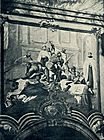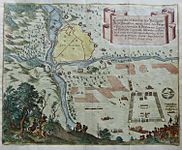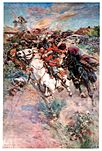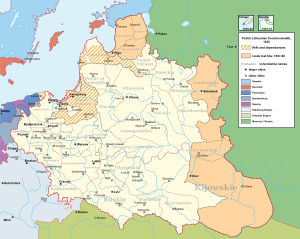Russo-Polish War (1654–1667) facts for kids
Quick facts for kids Russo-Polish War (1654–1667) |
|||||||||
|---|---|---|---|---|---|---|---|---|---|
|
|||||||||
|
|||||||||
| Belligerents | |||||||||
| Commanders and leaders | |||||||||
| Aleksey Trubetskoy, Bohdan Khmelnytsky, Yurii Khmelnytsky, Vasily Sheremetev, Vasiliy Buturlin, Ivan Khovansky, Yuri Dolgorukov, Prince Yakov Cherkassky |
Stefan Czarniecki, Wincenty Gosiewski, John II Casimir, Stanisław Lanckoroński, Jerzy Sebastian Lubomirski, Michał Kazimierz Pac, Aleksander Hilary Połubiński, Stanisław Rewera Potocki, Janusz Radziwiłł, Paweł Jan Sapieha, Ivan Vyhovsky, Pavlo Teteria, Petro Doroshenko |
||||||||
The Russo-Polish War (1654–1667) was a big conflict between the Tsardom of Russia and the Polish–Lithuanian Commonwealth. It is also known as the Thirteen Years' War. During part of this war, Sweden also attacked the Commonwealth. This period was called "The Deluge" in Poland.
At first, the Commonwealth faced many defeats. But they fought back and won some important battles. However, their economy was badly damaged, making it hard to keep fighting. Facing problems at home, the Commonwealth had to agree to a truce. The war ended with Russia gaining a lot of land. This war helped Russia become a powerful country in Eastern Europe.
Contents
Why the War Started
The war began because of the Khmelnytsky Rebellion. This was a revolt by Zaporozhian Cossacks against the Polish–Lithuanian Commonwealth. The Cossack leader, Bohdan Khmelnytsky, asked Tsar Alexei of Russia for help. He promised to be loyal to the Tsar in return.
In 1653, a big meeting in Russia decided to support the Cossacks. They agreed to protect Ukraine. After the Cossacks officially agreed to this at the Pereiaslav Council, war between Russia and Poland became certain.
Russia Invades the Commonwealth
In July 1654, a large Russian army of 41,000 soldiers attacked. They captured border forts like Bely and Dorogobuzh. Then, they began to surround the city of Smolensk.
The Russian army's position at Smolensk was risky. Prince Janusz Radziwiłł, a Lithuanian military leader, held the city of Orsha nearby. Russian forces, led by Prince Yuri Baryatinsky, made Radziwill retreat. This happened after battles near Shklov in August. Smolensk, a key city from an earlier war, fell to the Russians on September 23.
Meanwhile, other Russian armies also moved forward. Prince Aleksey Trubetskoy led troops into Ukraine. They quickly took over land between the Dnieper and Berezina rivers. His Ukrainian allies captured Homel. In the north, another Russian army took cities like Nevel, Polotsk, and Vitebsk.
By December, the Tsar's troops were in Polish Livonia. They took Ludza and Rezekne. At the same time, Cossack forces led by Khmelnitsky and Russian forces attacked Volynia. Despite some disagreements, they captured Ostroh and Rivne by the end of the year.
The 1655 Campaign
In early 1655, Prince Radziwill launched a counter-attack in Belarus. He recaptured Orsha and tried to take Mogilyov. This siege lasted three months but did not succeed. In January, Russian and Ukrainian forces were defeated at the Battle of Okhmativ. Another Polish army, helped by the Tatars, defeated a Russian-Ukrainian group at Zhashkov.
These losses worried the Tsar. He ordered a huge new attack. Lithuanian forces could not stop the Russians. Minsk fell to the Cossacks and Russians on July 3. Vilnius, the capital of Great Duchy of Lithuania, was captured by the Russians on July 31. After this, Kaunas and Hrodno were also taken in August.
Other Russian forces also had success. Prince Volkonsky sailed up the Dnieper and Pripyat rivers. He defeated Lithuanians and captured Pinsk. Trubetskoy's army took Slonim and Kletsk. Khmelnitsky and his allies attacked the Polish city of Lwów in September. They entered Lublin after a Polish defeat near Brest.
Truce and New Conflicts
The Russian advance into the Commonwealth led to Sweden invading Poland in 1655. This was part of the Second Northern War.
Russia then made a truce with Poland, called the Truce of Vilna, on November 2. After this, Russian forces fought Sweden in Livonia. They surrounded Riga in the Russo-Swedish War (1656–1658). Bohdan Khmelnytsky supported the Tsar's truce with Poland. When Khmelnytsky died in 1657, Ivan Vyhovsky became the new Cossack leader. He made an alliance with Poland in September 1658. This created the Grand Duchy of Ruthenia. However, the Cossacks also faced a civil war. They made a new agreement with Russia in 1659.
The Tsar made a good peace deal with Sweden. This allowed him to restart fighting Poland in October. In the north, a Polish attempt to block Vilnius was stopped. In the south, Vyhovsky failed to take Kiev from Russian control. However, in July 1659, Vyhovsky and his Tatar allies defeated a Russian army near Konotop.
The threat to the Russians in Ukraine lessened. Vyhovsky lost his alliance with the Crimean Khanate. An uprising started in Siever Ukraine against Vyhovsky. The rebelling Cossacks wanted Khmelnytsky's son, Yurii, to be the new leader. Vyhovsky was left with Polish troops and mercenaries. A meeting was held, and the union with Poland was declared unpopular. Vyhovsky had to give up his power.
Russian forces, surprised by the defeat at Konotop, tried to make peace. But the change in Cossack leadership helped Russia's influence in Ukraine. Yuri Khmelnytsky became the new leader. He was invited to sign a new treaty with Russia at Pereyaslav. When he arrived, he found himself ambushed.
End of the War
In 1660, things started to turn in favor of the Polish–Lithuanian Commonwealth. King John II Casimir had ended the war with Sweden. Now, he could focus all his forces on the war with Russia. Polish leaders defeated Russian forces in battles like the Battle of Polonka on June 27. Then, Polish armies attacked a Russian force at the Battle of Cudnów. They forced the Russian commander to surrender on November 2. These defeats made the Tsar agree to a new treaty with Sweden.
In July 1662, the Right-Bank Cossacks, supported by Polish and Tatar troops, were defeated. This happened in a large battle near Kaniv. Russian forces and Left-Bank Cossacks won this battle.
Towards the end of 1663, the Polish-Lithuanian King invaded Left-bank Ukraine. Most towns surrendered easily. But his attempt to take Hlukhiv in January failed. He also faced problems at Novgorod-Seversky. So, his campaign in Ukraine was not successful. Lithuanian forces did defeat a Russian army near Vitebsk in the summer. But overall, the 1664 campaigns were disappointing.
Peace talks continued from 1664 until January 1667. A civil war in Poland forced them to sign the Treaty of Andrusovo. In this treaty, the Polish–Lithuanian Commonwealth gave Russia the fortress of Smolensk. Russia also gained control of Ukraine on the left bank of the Dnieper River, including Kiev. The Commonwealth kept the right-bank Ukraine.
This war also brought big changes to the Russian military. It helped Russia move towards having a permanent army. This laid the groundwork for Russia's later military successes.
The war, happening during a time called the Deluge, was very bad for Poland. Even though Poland got back some land, the war greatly weakened the country. It made Poland more open to future Russian attacks. Poland could not stop the later Partitions of Poland, where Russia took a large part of its land.
See also
 In Spanish: Guerra ruso-polaca (1654-1667) para niños
In Spanish: Guerra ruso-polaca (1654-1667) para niños








